Fixed Focus Collimation Packages: FC/PC Connectors
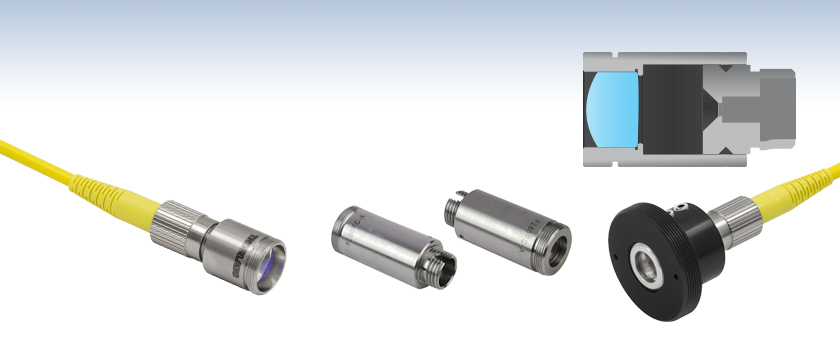
- Mates with FC/PC Connectors
- Simplifies Collimation of Output from Single Mode Fiber
- Collimated Beam Diameters Ranging from 0.63 mm to 4.0 mm
- Models Aligned at 13 Key Wavelengths from 405 nm to 4.55 µm
F240FC-B
633 nm, Focal Length: 7.93 mm
Shown with Patch Cable
F280FC-A
543 nm, Focal Length: 18.07 mm
Back
Front
Ø11 mm Collimator
Shown with AD11F
SM1-Threaded
Mounting Adapter
Fixed Focus Collimators Contain
One Factory-Aligned Aspheric Lens

Please Wait
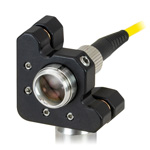
Click to Enlarge
AD12BA Adapter Used to Mount an F240FC-A Fixed Focus Collimation Package in a KM05 Kinematic Mount
Features
- Fiber Collimators with FC/PC Connectors (2.2 mm Wide Key) for Single Mode Patch Cables
- Collimators Aligned at Wavelengths from 405 nm to 4.55 µm (See Table to the Right)
- Collimated Beam Diameters from 0.63 mm to 4.0 mm Depending on Wavelength
- Each Collimation Package is Factory Aligned
- Simplifies Fiber-Coupled Detection Systems
- Non-Magnetic Stainless Steel Housing
- Compatible with Narrow and Wide Key FC/PC Connectors
- Custom Options, Including Custom Alignment Wavelengths, Available by Contacting Tech Sales
These fiber collimation packages are pre-aligned to collimate light from an FC/PC-terminated fiber with diffraction-limited performance. Because these fiber collimators have no movable parts, they are compact and easy to integrate into an existing setup. Due to chromatic aberration, the effective focal length (EFL) of the aspheric lens is wavelength dependent. The design wavelength indicates the wavelength of ideal beam divergence (see the Divergence Plots and Calculations tabs for more information). Collimation packages at select design wavelengths are available with different collimated beam diameters. Select a wavelength from the quick links table to the right for details.
The aspheric lens is factory aligned for collimation at the design wavelength when connected to its specified single mode fiber patch cable. In addition, the aspheric lens has an AR coating on both sides that minimizes surface reflections (see the AR Coating Plots tab). For some applications they may also be used at other wavelengths within the AR coating range; please refer to the theoretical divergence plot for each collimator to determine if it is appropriate for your application. The operating temperature range for these collimators is -40 °C to 93 °C. Please note that these collimation packages are not vacuum compatible. Collimation packages with custom alignment wavelengths, operating temperature ranges, or vacuum compatibility are available by contacting Tech Support.
These fiber collimators are intended for use with single mode fiber patch cables. For improved performance, we recommend using these collimators with our AR-coated single mode fiber optic patch cables. These cables feature an antireflective coating on one fiber end for increased transmission and improved return loss at the fiber-to-free-space interface. Please note performance specifications are guaranteed only when used with single mode fiber.
To mount these fiber collimation packages, we recommend using our collimator mounting adapters, including our kinematic collimator mounting adapters that provide pitch and yaw adjustment. In addition to Ø1/2" and Ø1" unthreaded versions, options are available with external SM05 (0.535"-40), RMS (0.800"-36), or SM1 (1.035"-40) threading. The collimation packages with external M12 x 0.5 threading can be mounted directly into our cage plate CP1M12(/M) to be integrated into our 30 mm cage systems.
Mid-IR Collimators
For our collimators with an alignment wavelength of 3.45 µm and 4.55 µm, we recommend using our fluoride fiber patch cables; these collimators include a tightly toleranced ceramic sleeve to protect the fluoride fiber tip during insertion and improve pointing stability. Although these collimators are factory aligned for a specific wavelength, they have low divergence angles over a broad range of wavelengths. Therefore, they may be used at other wavelengths within the AR coating range. Please refer to the theoretical divergence plot for each collimator to determine if it is appropriate for your application.
Alternatives
We also offer a line of adjustable collimation packages called FiberPorts that are well suited for a wide range of wavelengths. These are ideal solutions for adjustable, compact fiber couplers. For other collimation and coupling options, please see our Collimator Guide tab or contact Tech Support.
| Coating Information | |||||||
|---|---|---|---|---|---|---|---|
| Coating Designation | 405 | A | B | 1064 | C | D | E |
| Coating Range |
395 - 415 nm | 350 - 700 nm | 650 - 1050 nm | 1050 - 1075 nm | 1050 - 1620 nm or 1050 - 1700 nm |
1.8 - 3.0 µm | 3 - 5 µm |
| Reflectance | Ravg<0.25% @ 405 nm | Ravg < 0.5% within Coating Range |
Ravg < 0.5% within Coating Range |
<0.25% @ 1064 nm | Ravg < 0.5% within Coating Range |
Ravg < 1.0% within Coating Range |
Ravg < 1.0% within Coating Range |
| θ | Divergence Angle |
| D | Mode-Field Diameter (MFD) |
| f | Focal Length of Collimator |
The divergence angle (in degrees) ,
,
where D and f must be in the same units.
Divergence Angle Comparison
The divergence angle can be estimated using the formula shown to the right, given that the light emerging from the fiber has a Gaussian intensity profile. This formula works well for single mode fibers but will underestimate the divergence angle for multimode fibers where the light emerging from the fiber has a non-Gaussian intensity profile.
Simulations of the theoretical divergence when using one of our standard collimators at wavelengths other than the design wavelength are shown in the graphs below. For example, if you need to collimate 700 nm light from a fiber into a ~1.5 mm diameter beam, the F240FC-780 collimator (represented by the '-780' line in the F240 graph below) can be used but will provide a higher divergence than at its design wavelength of 780 nm. Individual theoretical divergence plots and raw data are also available below for each collimator. Please contact Tech Sales to request a collimator aligned at a custom wavelength.
Theoretical Approximation of the Divergence Angle
The beam diameter as a function of propagation distance was simulated for each of our collimators at the design wavelength, assuming input from the design fiber and a Gaussian intensity profile. The design wavelength and fiber are specified in the caption for each graph.
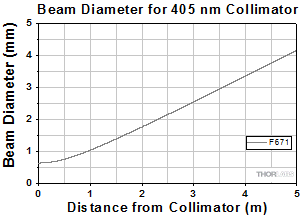
Click to Enlarge
At 405 nm with S405-XP Fiber
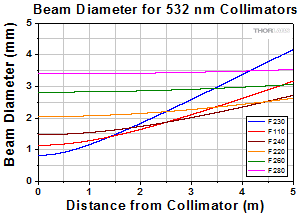
Click to Enlarge
At 532 nm with 460HP Fiber
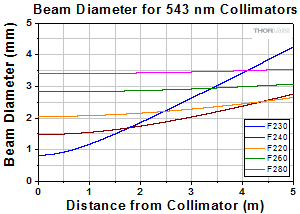
Click to Enlarge
At 543 nm with 460HP Fiber
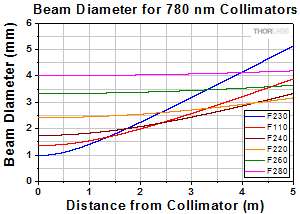
Click to Enlarge
At 780 nm with 780HP Fiber
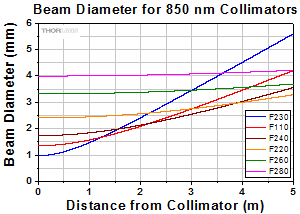
Click to Enlarge
At 850 nm with 780HP Fiber
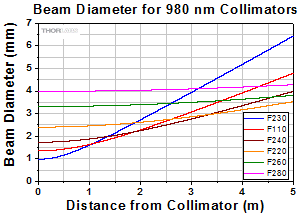
Click to Enlarge
At 980 nm with SM980-5.8-125 Fiber
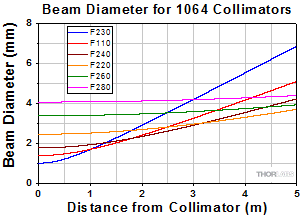
Click to Enlarge
At 1064 nm with SM980-5.8-125 Fiber
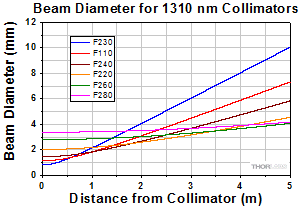
Click to Enlarge
At 1310 nm with SMF-28-J9 Fiber
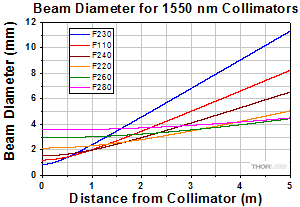
Click to Enlarge
At 1550 nm with SMF-28-J9 Fiber
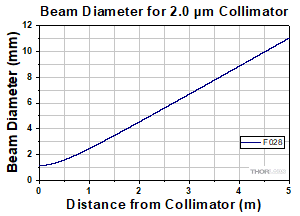
Click to Enlarge
At 2000 nm with SM2000 Fiber
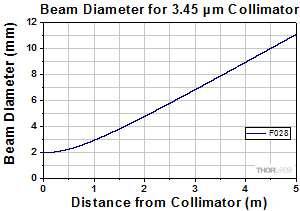
Click to Enlarge
At 3.45 µm with ZrF4 Fiber
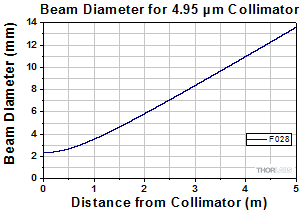
Click to Enlarge
At 4.55 µm with InF3 Fiber
Theoretical Approximation of the Divergence Angle
The full-angle beam divergence listed in the specifications tables is the theoretically-calculated value associated with the fiber collimator. This divergence angle is easy to approximate theoretically using the formula below as long as the light emerging from the fiber has a Gaussian intensity profile. Consequently, the formula works well for single mode fibers, but it will underestimate the divergence angle for multimode (MM) fibers since the light emerging from a multimode fiber has a non-Gaussian intensity profile.
The Full Divergence Angle (in degrees) is given by

where MFD is the mode field diameter and f is the focal length of the collimator. (Note: MFD and f must have the same units in this equation).
Example:
When the F220FC-A collimator (f ≈ 11.0 mm; not exact since the design wavelength is 543 nm) is used to collimate 515 nm light emerging from a 460HP fiber (MFD = 3.5 µm), the divergence angle is approximately given by
θ ≈ (0.0035 mm / 11.0 mm) x (180 / pi) = 0.018°.
When the beam divergence angle was measured for the F220FC-A collimator, a 460HP fiber was used with 543 nm light. The result was a divergence angle of 0.018°.
Theoretical Approximation of the Output Beam Diameter
The output beam diameter can be approximated from

where λ is the wavelength of light being used, MFD is the mode field diameter, and f is the focal length of the collimator. (Note: MFD and f must have the same units in this equation).
Example:
When the F240FC-1550 collimator (f = 8.18 mm) is used with the P1-SMF28E-FC-1 patch cable (MFD = 10.4 µm) and 1550 nm light, the output beam diameter is
d ≈ (4)(0.00155 mm)[8.18 mm / (pi · 0.0104 mm)] = 1.55 mm.
Theoretical Approximation of the Maximum Waist Distance
The maximum waist distance, which is the furthest distance from the lens the waist can be located in order to maintain collimation, may be approximated by

where f is the focal length of the collimator, λ is the wavelength of light used, and MFD is the mode field diameter. (Note: MFD and f must have the same units in this equation).
Example:
When the F220FC-532 collimator (f = 10.9 mm) is used with the P1-460B-FC-1 patch cable (MFD ≈ 4.0 µm; calculated approximate value) and 532 nm light, then the maximum waist distance is approximately
zmax ≈ 10.9 mm + [2 · (10.9 mm)2 · 0.000532 mm] / [pi · (0.004 mm)2] = 2526 mm.
Insights into Best Lab Practices
Scroll down to read about some practices we follow when setting up lab equipment.
- Align Fiber Collimators to Create Free Space Between Fibers
- Fiber Collimators: Tip for Mounting with Adapters
Click here for more insights into lab practices and equipment.
Align Fiber Collimators to Create Free Space Between Fibers
Two collimators, inserted into a fiber optic setup, provide free-space access to the beam. The first collimator accepts the highly diverging light from the first fiber and outputs a free-space beam, which propagates with an approximately constant diameter to the second collimator. The second collimator accepts the free-space beam and couples that light into the second fiber. Some collimation packages, including the pair used in this demonstration, are designed for use with optical fibers and mate directly to fiber connectors.
Ideally, 100% of the light emitted by the first fiber would be coupled into the second fiber, but some light will always be lost due to reflections, scattering, absorption, and misalignment. Misalignment, typically the largest source of loss, can be minimized using the alignment and stabilization techniques described in this video.
In this demonstration, the first fiber is single mode. The optical power incident on the second collimator, as well as the power output by the second fiber, are measured. When the second fiber is multimode with a 50 µm diameter core, alignment resulted in 91% of the power incident on the second collimator being measured at the fiber output. This value was 86% when the second fiber is single mode. Some differences in collimator designs, and their effects on the characteristics of the collimated beams, are also discussed.
If you would like more information about tips, tricks, and other methods we often use in the lab, we recommend our other Video Insights. In addition, our webinars provide practical and theoretical introductions to our different products.
| Products Featured During Demonstration | ||||
|---|---|---|---|---|
| Fiber-Coupled Laser | Kinematic Mounts | Fiber Adapter Cap (for Power Sensor) |
Single Mode Patch Cable (FC/PC) | Fiber Cable Storage Reels |
| Triplet Fiber Optic Collimators | Power Sensor | Power Meter | Hybrid Single Mode Patch Cable | 2" Posts |
| Adapter (Mount-to-Collimator) |
SM1 Thread Adapter (for Power Sensor) |
Fiber Connector Cleaner | Step-Index Multimode Patch Cable | Ø1/2" Post Holders |
Date of Last Edit: April 21, 2021
Fiber Collimators: Tip for Mounting with Adapters
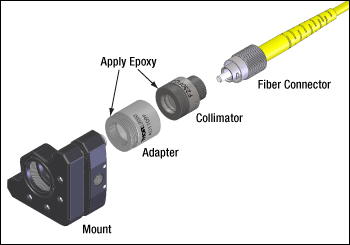
Click to Enlarge
Figure 1: The components shown above are joined using threaded interfaces. Since unscrewing the fiber connector could unintentionally loosen connections between the other components, Thorlabs suggests applying epoxy to the other two interfaces to immobilize them.
Fiber collimators are often used to introduce light into an optical setup from a fiber coupled source. Thorlabs offers a variety of fiber collimator packages, some only provide a smooth barrel (like the triplet collimators) and others have a metric thread at the end of the barrel (like the asphere collimators).
For both packages, Thorlabs typically suggests the use of an adapter with a nylon tipped set screw that holds the barrel against a two line contact.
Adapters for the external thread are available (AD1109F) that allow the user to thread the fiber collimator into a mount.
However, the use of these adapters results in a stack up of threaded interfaces (threaded fiber connector, threaded collimator, and threaded adapter). As a result, it is possible that unscrewing the fiber connector could inadvertently loosen another thread interface and create an unknown source of instability in the setup.
For this reason, Thorlabs suggests epoxying the threaded fiber collimators into the threaded mounts if that mounting mechanism is preferred.
Figure 1 indicates the assembly order and places to apply the epoxy.
Date of Last Edit: Dec. 4, 2019
Fiber Collimator Selection Guide
Click on the collimator type or photo to view more information about each type of collimator.
| Type | Description | |
|---|---|---|
| Fixed FC, APC, or SMA Fiber Collimators | 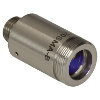 |
These fiber collimation packages are pre-aligned to collimate light from an FC/PC-, FC/APC-, or SMA-terminated fiber. Each collimation package is factory aligned to provide diffraction-limited performance for wavelengths ranging from 405 nm to 4.55 µm. Although it is possible to use the collimator at detuned wavelengths, they will only perform optimally at the design wavelength due to chromatic aberration, which causes the effective focal length of the aspheric lens to have a wavelength dependence. |
| Air-Spaced Doublet, Large Beam Collimators | 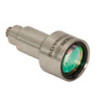 |
For large beam diameters (Ø5.3 - Ø8.5 mm), Thorlabs offers FC/APC, FC/PC, and SMA air-spaced doublet collimators. These collimation packages are pre-aligned at the factory to collimate a laser beam propagating from the tip of an FC or SMA-terminated fiber and provide diffraction-limited performance at the design wavelength. |
| Triplet Collimators | 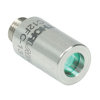 |
Thorlabs' High Quality Triplet Fiber Collimation packages use air-spaced triplet lenses that offer superior beam quality performance when compared to aspheric lens collimators. The benefits of the low-aberration triplet design include an M2 term closer to 1 (Gaussian), less divergence, and less wavefront error. |
| Achromatic Collimators for Multimode Fiber | 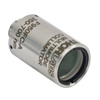 |
Thorlabs' High-NA Achromatic Collimators pair a meniscus lens with an achromatic doublet for high performance across the visible to near-infrared spectrum with low spherical aberration. Designed for use with high-NA multimode fiber, these collimators are ideal for Optogenetics and Fiber Photometry applications. |
| Reflective Collimators | 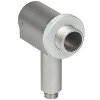 |
Thorlabs' metallic-coated Reflective Collimators are based on a 90° off-axis parabolic mirror. Mirrors, unlike lenses, have a focal length that remains constant over a broad wavelength range. Due to this intrinsic property, a parabolic mirror collimator does not need to be adjusted to accommodate various wavelengths of light, making them ideal for use with polychromatic light. Our fixed reflective collimators are recommended for collimating single and multimode fiber and coupling into multimode fiber. These collimators are available with UV-enhanced aluminum or protected silver reflective coatings and with FC/PC, FC/APC, or SMA connector compatibility. |
| Compact Reflective Collimators |  |
Thorlabs' Compact Reflective Collimators incorporate a 90° off-axis parabolic mirror with a protected silver coating. Because the focal length is independent of wavelength for an off-axis parabolic mirror, they are ideal for use with polychromatic light. Our fixed reflective collimators are recommended for collimating single and multimode fiber and coupling into multimode fiber. These collimators are directly compatible with our 16 mm cage system. They are available with FC/PC, FC/APC, or SMA connector inputs. |
| Adjustable Reflective Collimators | 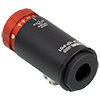 |
Thorlabs' Adjustable Focus Reflective Collimators are based on a 90° off-axis parabolic (OAP) mirror with a protected silver coating. The adjustable fiber-to-OAP distance, combined with the OAP having a constant focal length across wavelengths, makes these collimators ideal for optimizing collimation or coupling of polychromatic light with single mode or multimode fiber. These adjustable collimators have a 15 mm reflected focal length and are available with FC/PC, FC/APC, or SMA connectors. |
| FiberPorts | 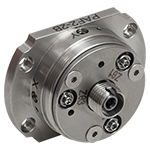 |
These compact, ultra-stable FiberPort micropositioners provide an easy-to-use, stable platform for coupling light into and out of FC/PC, FC/APC, or SMA terminated optical fibers. It can be used with single mode, multimode, or PM fibers and can be mounted onto a post, stage, platform, or laser. The built-in aspheric or achromatic lens is available with five different AR coatings and has five degrees of alignment adjustment (3 translational and 2 pitch). The compact size and long-term alignment stability make the FiberPort an ideal solution for fiber coupling, collimation, or incorporation into OEM systems. |
| Adjustable Fiber Collimators |  |
These collimators are designed to connect onto the end of an FC/PC, FC/APC, or SMA connector and contain an AR-coated aspheric lens. The distance between the aspheric lens and the tip of the fiber can be adjusted to compensate for focal length changes or to recollimate the beam at the wavelength and distance of interest. |
| Achromatic Fiber Collimators with Adjustable Focus |  |
Thorlabs' Achromatic Fiber Collimators with Adjustable Focus are designed with an effective focal length (EFL) of 20 mm, 40 mm, or 80 mm, have optical elements broadband AR coated for one of three wavelength ranges, and are available with FC/PC, FC/APC, or SMA905 connectors. A four-element, air-spaced lens design produces superior beam quality (M2 close to 1) and less wavefront error when compared to aspheric lens collimators. These collimators can be used for free-space coupling into a fiber, collimation of output from a fiber, or in pairs for collimator-to-collimator coupling over long distances, which allows the beam to be manipulated prior to entering the second collimator. |
| Zoom Fiber Collimators | 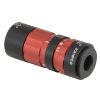 |
These collimators provide a variable focal length between 6 and 18 mm, while maintaining the collimation of the beam. As a result, the size of the beam can be changed without altering the collimation. This universal device saves time previously spent searching for the best suited fixed fiber collimator and has a very broad range of applications. They are offered with FC/PC, FC/APC, or SMA905 connectors with three different antireflection wavelength ranges to choose from. |
| Single Mode Pigtailed Collimators | 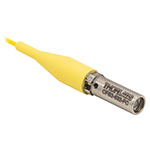 |
Our single mode pigtailed collimators come with one meter of fiber, consist of an AR-coated aspheric lens pre-aligned with respect to a fiber, and are collimated at one of eight wavelengths: 532 nm, 633 nm, 780 nm, 850 nm, 1030 nm, 1064 nm, 1310 nm, or 1550 nm. Although it is possible to use the collimator at any wavelength within the coating range, the coupling loss will increase as the wavelength is detuned from the design wavelength. |
| Polarization Maintaining Pigtailed Collimators | 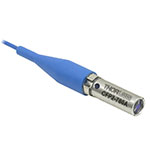 |
Our polarization maintaining pigtailed collimators come with one meter of fiber, consist of an AR-coated aspheric lens pre-aligned with respect to a fiber, and are collimated at one of five wavelengths: 633 nm, 780 nm, 980 nm, 1064 nm, or 1550 nm. Custom wavelengths and connectors are available as well. A line is engraved along the outside of the housing that is parallel to the fast axis. As such, it can be used as a reference when polarized light is launched accordingly. Although it is possible to use the collimator at any wavelength within the coating range, the coupling loss will increase as the wavelength is detuned from the design wavelength. |
| GRIN Fiber Collimators | 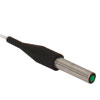 |
Thorlabs offers gradient index (GRIN) fiber collimators that are aligned at a variety of wavelengths from 630 to 1550 nm and have either FC terminated, APC terminated, or unterminated fibers. Our GRIN collimators feature a Ø1.8 mm clear aperture, are AR-coated to ensure low back reflection into the fiber, and are coupled to standard single mode or graded-index multimode fibers. |
| GRIN Lenses | 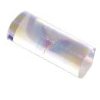 |
These graded-index (GRIN) lenses are AR coated for applications at 630, 830, 1060, 1300, or 1560 nm that require light to propagate through one fiber, then through a free-space optical system, and finally back into another fiber. They are also useful for coupling light from laser diodes into fibers, coupling the output of a fiber into a detector, or collimating laser light. Our GRIN lenses are designed to be used with our Pigtailed Glass Ferrules and GRIN/Ferrule sleeves. |
| Posted Comments: | |
Ann Fitzpatrick
(posted 2024-05-21 09:46:32.47) Is there and data on how temerature affect the collimation for F280FC-780?
Many thanks cdolbashian
(posted 2024-05-24 12:19:53.0) Thank you for reaching out to us. Depending on your temperature extremes you may or may not have significant thermal lensing. The glass used in this collimator is D-ZK3. I have contacted you directly to discuss your usage and some more properties of the glass used. Ruben Deckers
(posted 2024-04-12 13:36:17.397) I'm interested in the maximum angle at which light can be coupled back into the collimator and still be accepted by the fiber. For this I would need the refractive index of the material used in the lens or the radius of the curved part of the lens. Either would help me out massively!
Thanks in advance!
Kind regards jdelia
(posted 2024-04-18 12:09:59.0) Thank you for contacting Thorlabs. The lens used is our 354280-C aspheric lens, which is made out of a D-ZK3 substrate. I have reached out to you directly to provide the exact values you have requested. user
(posted 2024-02-21 11:16:59.803) Are the fc/pc collimators also compatible with fc/upc fibers? I have two of these collimators set up very similar to the example video, with both on kinematic mounts on posts and post holders that are identical, but I am unable to get more than a few nw of output from a several mw laser. cdolbashian
(posted 2024-03-15 04:06:37.0) Thank you for reaching out to us with this inquiry. For applications involving single mode fiber coupling, the cause of low coupling efficiency is typically due to alignment, rather than fiber type, as the differences between PC and UPC are not significant enough to cause this type of coupling error. I have contacted you directly to suggest some alignment methods. user
(posted 2024-01-11 08:23:24.083) I am looking to design the F260FC-1550 collimator into a system which will require the collimated output beam to be accurately aligned to a target. To achieve this the design will incorporate an alignment system. Ideally the adjustment range provided should be no greater than necessary in order to maximise adjustment resolution. I therefore need to know the maximum limit for the angle between the output beam and the collimator mechanical axis for this collimator type.
Many thanks in anticipation.
Ian. jpolaris
(posted 2024-01-11 03:36:13.0) Thank you for contacting Thorlabs. Unfortunately, pointing error is not something that we measure for this line of fixed focus collimators. However, we do specify a < 10 mrad pointing error for our FC/PC and FC/APC connectorized reflective collimators. I have reached out to you directly to discuss further. The following link will take you to the reflective collimators that I am referring to. https://www.thorlabs.com/newgrouppage9.cfm?objectgroup_id=4093&tabname=Specs ILIYA SHOFMAN
(posted 2023-11-21 02:23:58.08) Could you please include the typical values for return loss of these fixed-focus fiber collimator packages? Also, what coupling efficiency can one achieve with them? ksosnowski
(posted 2023-11-29 01:09:52.0) Thanks for reaching out to Thorlabs. We provide the typical transmission values for the AR coated lenses used in these fixed focus collimators however coupling efficiency when launching from freespace into fiber will also be dependent upon the input beam parameters and alignment, as well as the fiber type used to couple into. When we make these collimators we directly test the output beam parameters when aligning the lens with a fiber-coupled laser input before setting it in place with epoxy to ensure consistent performance and prevent drift. Currently we do not have specific sample data for coupling efficiency from freespace into fiber with these collimators. Kyesung Lee
(posted 2023-07-06 17:07:40.68) The fiber receptacles are narrow or wide key? cdolbashian
(posted 2023-07-13 01:49:41.0) Thank you for reaching out to us with this inquiry! These receptacles are 2.2mm wide key. Li Zong yue
(posted 2022-08-18 10:50:04.98) I want to know the damage threshold of this collimator for continuous wave ksosnowski
(posted 2022-08-23 01:19:59.0) Hello Li, thanks for reaching out to Thorlabs. We have not tested an exact CW limit for these, however the damage threshold for these fixed collimators is limited normally not by the lens surface rather by the epoxy used to fix the lens in place, or by the fiber connector epoxy. Typically we expect the limit at 1064nm to be in the neighborhood of 350mW before the connector epoxy will soften, and this varies some with wavelength. We recommend to avoid overfilling the lens or the fiber to reduce these risks of thermal damage, as these conditions can increase the amount of light converted to heat. Nathan Eschbach
(posted 2022-06-27 17:22:34.523) Can this collimator be used in the reverse direction to couple light to the fiber? My application involves collimating a beam, passing it through a medium, then reflecting back through and into the collimator to couple to the fiber. Is this feasible? Does AR coating effect this? cdolbashian
(posted 2022-07-06 09:02:41.0) Thank you for reaching out to us Nathan. Indeed a collimator can be used in the reverse direction for coupling. I have reached out to you directly to chat about your specific application. For future application-based questions, feel free to contact us at techsupport@thorlabs.com Kate Whittakaer
(posted 2021-10-25 09:58:36.483) Hi,
What kind of toelrance on pointing accuracy/centration can I expect from the F230FC-780?
Best Wishes,
Kate azandani
(posted 2021-10-27 04:43:37.0) Hello Kate, thank you for contacting Thorlabs. Unfortunately, we do not measure or specify this value for this product. If a specific pointing accuracy is needed, we can certainly arrange a custom item. I have reached out directly to discuss this further. kimsw0429
(posted 2018-06-06 21:26:22.217) F240FC-B
I don't know how to calculate the Diameter when The laser progresses 1m from focal length.
Can u explain? YLohia
(posted 2018-06-22 02:55:53.0) Hello, thank you for contacting Thorlabs. We have a tutorial here (https://www.thorlabs.com/newgrouppage9.cfm?objectgroup_id=944&tabname=Calculations) that shows how to calculate that. I have reached out to you directly in case you have further questions. melanie.macioce
(posted 2017-09-21 10:05:01.677) Hello,
I am looking for 2 fibered collimators and I wanted to know the damage threshold for 3 components :
- F240FC-980
- F230FC-780
- F240FC-780
Thank you in advance tfrisch
(posted 2017-11-01 10:46:11.0) Hello, thank you for contacting Thorlabs. The damage threshold will depend on many factors including whether the light is being collimated from fiber or coupled into fiber. Typically, the limiting factor will be the epoxy that holds the lens in the collimator when collimating, or the epoxy that holds the fiber in the connector when coupling. Avoid overfilling the lens or the fiber to reduce these risks of damage. 300mW is our general rule of thumb for power in a connectorized fiber, but we will reach out to you directly to discuss increasing that to the order of watts. radhakrishna.87
(posted 2017-04-13 00:13:50.067) Are fiber patch cables Thorlabs part number "P1-780PMAR-2" and Thorlabs model "P1-780A-FC-1" are appropriate to use with the Thorlabs Collimator "F220FC-780". Kindly suggest. jlow
(posted 2017-04-17 11:26:40.0) Response from Jeremy at Thorlabs: If you are using these with 780nm light, then the collimator is appropriate. ygv7535698
(posted 2017-03-01 13:25:04.24) Hello,did your company has a focus lens that Mates with FC/PC Connectors and Simplifies focuser of Output from Single Mode Fiber
thank you jlow
(posted 2017-03-01 01:52:59.0) Response from Jeremy at Thorlabs: You can use our Ø11mm fixed collimators with the AD1109F adapter and an M9 thread aspheric lens to focus the output from a single mode fiber.
AD1109F: https://www.thorlabs.com/newgrouppage9.cfm?objectgroup_id=219&pn=AD1109F
Aspheric lens: https://www.thorlabs.com/navigation.cfm?guide_id=2344 chiwen.cheng
(posted 2016-09-06 12:39:16.89) Could this collimator be used in collecting line scattering light into PMT detector? I want to use fiber to save space, but I have no experience with it. Thank you! tfrisch
(posted 2016-09-07 02:59:55.0) Hello, thank you for contacting Thorlabs. A collimator can be used in reverse to couple light into fiber, but keep in mind that the rays best coupled will be parallel to the axis of the lens (a collimated input). I will contact you directly about collecting scattered light. fc975
(posted 2015-07-07 11:52:13.543) Hello,
I would like to use a collimator in combination with a fiber optic spectrometer for fluorescence measurements to increase Signal-to-Noise-Ratio,
I am measuring the fluorescence emitted by a solid surface
is there a specific model you can recommend?
Thanks,
Filippo besembeson
(posted 2015-09-23 09:34:22.0) Response from Bweh at Thorlabs USA: I will followup with you to further discuss your application requirements. ludoangot
(posted 2015-06-03 14:34:02.843) These collimators are described for use in collimating light output from the fiber, could you please explain what limits their use to focus a collimated light into the fiber? jlow
(posted 2015-06-05 10:01:21.0) Response from Jeremy at Thorlabs: The collimator can be used to focus light into a fiber as well. You will need to match the focused spot size to the MFD of the fiber for optimal coupling. It is also recommended to use kinematic mounts with this to optimize the alignment. frank.kallmeyer
(posted 2014-12-12 15:04:59.9) What is the mechanical accuracy of the FC-PC connector? Is it in compliance with the EN 61754-13? What is the quality grade of the FC-PC connector? jlow
(posted 2014-12-19 09:09:46.0) Response from Jeremy at Thorlabs: The FC receptacle will accept FC/PC connectors defined in IEC61754-13. I will contact you directly to provide more details on the collimator. jlow
(posted 2014-08-19 09:12:37.577) Response from Jeremy at Thorlabs: Even with the focal length shift, you should still be able to get something on the output side. From your description, it seems like the alignment is off. I would suggest adjusting the X/Y position and angle of the collimator with respect to your beam. user
(posted 2014-08-17 08:25:12.297) I have a collimator (F280FC-B) connected to a MMF of 50um core diameter with FC/PC connector and NA of 0.2. I am trying to focus a collimated laser beam of 900nm with 1.5mm beam diameter. I measure the output power and get nothing. When not using the lens I can get some of the energy directly to the fiber. Is it because of the focal length shift in this wavelength? ihincks
(posted 2013-10-11 11:39:53.843) I have a collimator (F240FC-A) connected to both sides of a single mode polarization maintaining fibre (532nm). I am sending collimated light in one side and hoping for collimated light out the other side.
However, I am getting out an ugly beam; there are prominent rings surrounding the central peak of comparable size to the central peak. Is it possible that I am using it improperly, or is it defective? I can send you pictures of the beam if you'd like. jlow
(posted 2013-10-15 08:25:00.0) Response from Jeremy at Thorlabs: We will get in contact with you directly to discuss about this issue. tschalk
(posted 2013-01-09 11:33:00.0) This is a feedback from Thomas at Thorlabs. Thank you very much for your inquiry. The polarimeter head is equipped with a little socket screw on the side. It is a very tiny hole at the left side when you look to the front side of the polarimeter head. The collimator is shipped with a suitable Allan key. If you have placed the collimator into the polarimeter head than you can fix it by tightening the screw. user
(posted 2013-01-09 06:11:15.68) Dear Sir/Madam,
I am currently using the F230FC-A in combination with a Polarimeter, the PAX5710VIS. I was wondering whether you could recommend a way to secure the collimator in the polarimeter in a fixed position, so that the fiber can be removed from the collimator without adjusting the orientation. Although the collimator is threaded, there is currently no way to do this. Or am I overlooking the obvious? klee
(posted 2009-09-08 17:40:56.0) A response from Ken at Thorlabs to luc.rossey: Is the 40cm of space between the laser and fiber necessary? If not, you can use our FiberPorts coupler to couple the light into the fiber. FiberPorts can be attached to HeNe lasers directly using the HCL adapter. luc.rossey
(posted 2009-08-08 04:50:07.0) I want to conduct a didactical interference experiment in wich I need to couple a free space laserbeam from my NeHe lasersource to a single mode fiber and out to my detector. The fiber needs to be 80 m of lenght and at both end there has to be a fiber collimator aspheric lens package . I am but an amateur and I have no idee from which to chose. There will be about 40 cm of space between the lasersource and one end of the fiber. Could you help me please. |

| Item # | Alignment Wavelengtha |
Lens AR Coating | Waist Diameterb | Waist Distancec | Full Angle Divergenced | Theoretical Divergence |
NA | Focal Lengthe | Housing Outer Diameterf |
External Threadingf |
|---|---|---|---|---|---|---|---|---|---|---|
| F671FC-405 | 405 nm | 395 - 415 nm Ravg < 0.25% |
0.63 mm | 3.56 mm | 0.05° +0.01 / -0.00° | Raw Data |
0.60 | 4.02 mm | 11 mm | M11 x 0.5 |

| Item # | Alignment Wavelengtha |
Lens AR Coating | Waist Diameterb | Waist Distancec | Full-Angle Divergence | Theoretical Divergence |
NA | Focal Lengthd | Housing Outer Diameter |
External Threading |
|---|---|---|---|---|---|---|---|---|---|---|
| F110FC-532 | 532 nm | 350 - 700 nm Ravg < 0.5% |
1.14 mm | 5.85 mm | 0.03 +0.01 / -0.00°e | Raw Data |
0.38 | 6.09 mm | 11 mmg | M11 x 0.5g |
| F240FC-532 | 532 nm | 350 - 700 nm Ravg < 0.5% |
1.48 mm | 6.96 mm | 0.03 +0.01 / -0.00°f | Raw Data |
0.51 | 7.86 mm | 12 mmh | M12 x 0.5h |
| F220FC-532 | 532 nm | 350 - 700 nm Ravg < 0.5% |
2.1 mm | 10.72 mm | 0.02 +0.01 / -0.00°f | Raw Data |
0.25 | 10.90 mm | 11 mmg | M11 x 0.5g |

| Item # | Alignment Wavelengtha |
Lens AR Coating | Waist Diameterb | Waist Distancec | Full-Angle Divergenced | Theoretical Divergence |
NA | Focal Lengthe | Housing Outer Diameter |
External Threading |
|---|---|---|---|---|---|---|---|---|---|---|
| F230FC-A | 543 nm | 350 - 700 nm Ravg < 0.5% |
0.8 mm | 4.02 mm | 0.049° | Raw Data |
0.57 | 4.34 mm | 11 mmf | M11 x 0.5f |
| F240FC-A | 543 nm | 350 - 700 nm Ravg < 0.5% |
1.5 mm | 6.97 mm | 0.027° | Raw Data |
0.51 | 7.86 mm | 12 mmg | M12 x 0.5g |
| F220FC-A | 543 nm | 350 - 700 nm Ravg < 0.5% |
2.0 mm | 10.74 mm | 0.020° | Raw Data |
0.25 | 10.92 mm | 11 mmf | M11 x 0.5f |
| F260FC-A | 543 nm | 350 - 700 nm Ravg < 0.5% |
2.8 mm | 14.85 mm | 0.01 +0.01 / -0.00° | Raw Data |
0.17 | 15.01 mm | 11 mmf | M11 x 0.5f |
| F280FC-A | 543 nm | 350 - 700 nm Ravg < 0.5% |
3.3 mm | 17.40 mm | 0.012 +0.01 / -0.00° | Raw Data |
0.15 | 18.07 mm | 11 mmf | M11 x 0.5f |

| Item # | Alignment Wavelengtha |
Lens AR Coating | Waist Diameterb | Waist Distancec | Full-Angle Divergenced | Theoretical Divergence |
NA | Focal Lengthe | Housing Outer Diameter |
External Threading |
|---|---|---|---|---|---|---|---|---|---|---|
| F230FC-B | 633 nm | 650 - 1050 nm Ravg < 0.5%f |
0.8 mm | 4.07 mm | 0.056° | Raw Data |
0.56 | 4.43 mm | 11 mmg | M11 x 0.5g |
| F110FC-633 | 633 nm | 350 - 700 nm Ravg < 0.5% |
1.16 mm | 5.93 mm | 0.04 +0.01 / -0.00° | Raw Data |
0.38 | 6.17 mm | 11 mmg | M11 x 0.5g |
| F240FC-B | 633 nm | 650 - 1050 nm Ravg < 0.5%f |
1.5 mm | 6.96 mm | 0.031° | Raw Data |
0.50 | 7.93 mm | 12 mmh | M12 x 0.5h |
| F220FC-B | 633 nm | 650 - 1050 nm Ravg < 0.5%f |
2.1 mm | 10.83 mm | 0.022° | Raw Data |
0.25 | 10.99 mm | 11 mmg | M11 x 0.5g |
| F260FC-B | 633 nm | 650 - 1050 nm Ravg < 0.5%f |
2.8 mm | 14.87 mm | 0.016 +0.01 / -0.00° | Raw Data |
0.16 | 15.15 mm | 11 mmg | M11 x 0.5g |
| F280FC-B | 633 nm | 650 - 1050 nm Ravg < 0.5%f |
3.4 mm | 17.52 mm | 0.014 +0.01 / -0.00° | Raw Data |
0.15 | 18.24 mm | 11 mmg | M11 x 0.5g |

| Item # | Alignment Wavelengtha |
Lens AR Coating | Waist Diameterb | Waist Distancec | Full-Angle Divergence | Theoretical Divergence |
NA | Focal Lengthd | Housing Outer Diameter |
External Threading |
|---|---|---|---|---|---|---|---|---|---|---|
| F230FC-780 | 780 nm | 650 - 1050 nm Ravg < 0.5% |
0.98 mm | 4.12 mm | 0.06 +0.01 / -0.00°e | Raw Data |
0.55 | 4.51 mm | 11 mmg | M11 x 0.5g |
| F110FC-780 | 780 nm | 650 - 1050 nm Ravg < 0.5% |
1.36 mm | 6.00 mm | 0.04 +0.01 / -0.00°f | Raw Data |
0.37 | 6.24 mm | 11 mmg | M11 x 0.5g |
| F240FC-780 | 780 nm | 650 - 1050 nm Ravg < 0.5% |
1.5 mm | 7.09 mm | 0.036°f | Raw Data |
0.50 | 8.00 mm | 12 mmh | M12 x 0.5h |
| F220FC-780 | 780 nm | 650 - 1050 nm Ravg < 0.5% |
2.1 mm | 10.91 mm | 0.026°f | Raw Data |
0.26 | 11.07 mm | 11 mmg | M11 x 0.5g |
| F260FC-780 | 780 nm | 650 - 1050 nm Ravg < 0.5% |
3.33 mm | 15.11 mm | 0.02 +0.01 / -0.00°e | Raw Data |
0.16 | 15.29 mm | 11 mmg | M11 x 0.5g |
| F280FC-780 | 780 nm | 650 - 1050 nm Ravg < 0.5% |
4.00 mm | 17.68 mm | 0.01 +0.01 / -0.00°e | Raw Data |
0.15 | 18.40 mm | 11 mmg | M11 x 0.5g |

| Item # | Alignment Wavelengtha |
Lens AR Coating | Waist Diameterb | Waist Distancec | Full-Angle Divergence | Theoretical Divergence |
NA | Focal Lengthd | Housing Outer Diameter |
External Threading |
|---|---|---|---|---|---|---|---|---|---|---|
| F230FC-850 | 850 nm | 650 - 1050 nm Ravg < 0.5% |
0.98 mm | 4.13 mm | 0.06 +0.01 / -0.00°e | Raw Data |
0.49 | 4.53 mm | 11 mmg | M11 x 0.5g |
| F110FC-850 | 850 nm | 650 - 1050 nm Ravg < 0.5% |
1.36 mm | 6.02 mm | 0.05 +0.01 / -0.00°f | Raw Data |
0.37 | 6.26 mm | 11 mmg | M11 x 0.5g |
| F240FC-850 | 850 nm | 650 - 1050 nm Ravg < 0.5% |
1.74 mm | 7.11 mm | 0.04 +0.01 / -0.00°e | Raw Data |
0.50 | 8.02 mm | 12 mmh | M12 x 0.5h |
| F220FC-850 | 850 nm | 650 - 1050 nm Ravg < 0.5% |
2.41 mm | 10.94 mm | 0.03 +0.01 / -0.00°e | Raw Data |
0.25 | 11.12 mm | 11 mmg | M11 x 0.5g |
| F260FC-850 | 850 nm | 650 - 1050 nm Ravg < 0.5% |
3.32 mm | 15.15 mm | 0.02 +0.01 / -0.00°e | Raw Data |
0.16 | 15.33 mm | 11 mmg | M11 x 0.5g |
| F280FC-850 | 850 nm | 650 - 1050 nm Ravg < 0.5% |
3.99 mm | 17.73 mm | 0.02 +0.01 / -0.00°e | Raw Data |
0.15 | 18.45 mm | 11 mmg | M11 x 0.5g |

| Item # | Alignment Wavelengtha |
Lens AR Coating | Waist Diameterb | Waist Distancec | Full-Angle Divergence | Theoretical Divergence |
NA | Focal Lengthd | Housing Outer Diameter |
External Threading |
|---|---|---|---|---|---|---|---|---|---|---|
| F230FC-980 | 980 nm | 650 - 1050 nm Ravg < 0.5% |
1.0 mm | 4.2 mm | 0.073 +0.010 / -0.000e | Raw Data |
0.49 | 4.55 mm | 11 mmg | M11 x 0.5g |
| F110FC-980 | 980 nm | 650 - 1050 nm Ravg < 0.5% |
1.35 mm | 6.05 mm | 0.05 +0.01 / -0.00°e | Raw Data |
0.37 | 6.29 mm | 11 mmg | M11 x 0.5g |
| F240FC-980 | 980 nm | 650 - 1050 nm Ravg < 0.5% |
1.7 mm | 7.15 mm | 0.04 +0.01 / -0.00°f | Raw Data |
0.50 | 8.06 mm | 12 mmh | M12 x 0.5h |
| F220FC-980 | 980 nm | 650 - 1050 nm Ravg < 0.5% |
2.4 mm | 10.99 mm | 0.03 +0.01 / -0.00°f | Raw Data |
0.25 | 11.16 mm | 11 mmg | M11 x 0.5g |
| F280FC-980 | 980 nm | 650 - 1050 nm Ravg < 0.5% |
4.0 mm | 17.81 mm | 0.02 +0.01 / -0.00°f | Raw Data |
0.15 | 18.53 mm | 11 mmg | M11 x 0.5g |

| Item # | Alignment Wavelengtha |
Lens AR Coating | Waist Diameterb | Waist Distancec | Full-Angle Divergenced | Theoretical Divergence |
NA | Focal Lengthe | Housing Outer Diameter |
External Threading |
|---|---|---|---|---|---|---|---|---|---|---|
| F230FC-1064 | 1064 nm | 650 - 1050 nm Ravg < 0.5% |
1.0 mm | 4.2 mm | 0.08 +0.01 / -0.00° | Raw Data |
0.55 | 4.56 mm | 11 mmf | M11 x 0.5f |
| F110FC-1064 | 1064 nm | 1050 - 1700 nm Ravg < 0.5% |
1.38 mm | 6.07 mm | 0.06 +0.01 / -0.00° | Raw Data |
0.37 | 6.31 mm | 11 mmf | M11 x 0.5f |
| F240FC-1064 | 1064 nm | 650 - 1050 nm Ravg < 0.5% |
1.8 mm | 7.2 mm | 0.04 +0.01 / -0.00° | Raw Data |
0.50 | 8.07 mm | 12 mmg | M12 x 0.5g |
| F220FC-1064 | 1064 nm | 1050 - 1075 nm R < 0.25% |
2.4 mm | 11.02 mm | 0.032° | Raw Data |
0.25 | 11.17 mm | 11 mmf | M11 x 0.5f |
| F260FC-1064 | 1064 nm | 650 - 1050 nm Ravg < 0.5% |
3.4 mm | 15.3 mm | 0.02 +0.01 / -0.00° | Raw Data |
0.16 | 15.43 mm | 11 mmf | M11 x 0.5f |

| Item # | Alignment Wavelengtha |
Lens AR Coating | Waist Diameterb | Waist Distancec | Full-Angle Divergenced | Theoretical Divergence |
NA | Focal Lengthe | Housing Outer Diameter |
External Threading |
|---|---|---|---|---|---|---|---|---|---|---|
| F230FC-C | 1310 nm | 1050 - 1620 nm Ravg < 0.5% |
0.8 mm | 4.20 mm | 0.114° | Raw Data |
0.53 | 4.64 mm | 11 mmf | M11 x 0.5f |
| F110FC-1310 | 1310 nm | 1050 - 1700 nm Ravg < 0.5% |
1.15 mm | 6.10 mm | 0.08 +0.01 / -0.00° | Raw Data |
0.37 | 6.35 mm | 11 mmf | M11 x 0.5f |
| F240FC-C | 1310 nm | 1050 - 1620 nm Ravg < 0.5% |
1.5 mm | 7.21 mm | 0.065° | Raw Data |
0.49 | 8.13 mm | 12 mmg | M12 x 0.5g |
| F220FC-C | 1310 nm | 1050 - 1620 nm Ravg < 0.5% |
2.0 mm | 11.08 mm | 0.047° | Raw Data |
0.24 | 11.23 mm | 11 mmf | M11 x 0.5f |
| F260FC-C | 1310 nm | 1050 - 1620 nm Ravg < 0.5% |
2.8 mm | 15.35 mm | 0.034° | Raw Data |
0.16 | 15.52 mm | 11 mmf | M11 x 0.5f |
| F280FC-C | 1310 nm | 1050 - 1620 nm Ravg < 0.5% |
3.4 mm | 17.96 mm | 0.028° | Raw Data |
0.15 | 18.67 mm | 11 mmf | M11 x 0.5f |

| Item # | Alignment Wavelengtha |
Lens AR Coating | Waist Diameterb | Waist Distancec | Full-Angle Divergenced | Theoretical Divergence |
NA | Focal Lengthe | Housing Outer Diameter |
External Threading |
|---|---|---|---|---|---|---|---|---|---|---|
| F230FC-1550 | 1550 nm | 1050 - 1620 nm Ravg < 0.5% |
0.9 mm | 4.21 mm | 0.128° | Raw Data |
0.53 | 4.67 mm | 11 mmf | M11 x 0.5f |
| F110FC-1550 | 1550 nm | 1050 - 1700 nm Ravg < 0.5% |
1.21 mm | 6.13 mm | 0.09 +0.01 / -0.00° | Raw Data |
0.37 | 6.37 mm | 11 mmf | M11 x 0.5f |
| F240FC-1550 | 1550 nm | 1050 - 1620 nm Ravg < 0.5% |
1.6 mm | 7.26 mm | 0.073° | Raw Data |
0.49 | 8.18 mm | 12 mmg | M12 x 0.5g |
| F220FC-1550 | 1550 nm | 1050 - 1620 nm Ravg < 0.5% |
2.1 mm | 11.15 mm | 0.053° | Raw Data |
0.24 | 11.29 mm | 11 mmf | M11 x 0.5f |
| F260FC-1550 | 1550 nm | 1050 - 1620 nm Ravg < 0.5% | 3.0 mm | 15.44 mm | 0.038° | Raw Data |
0.16 | 15.58 mm | 11 mmf | M11 x 0.5f |
| F280FC-1550 | 1550 nm | 1050 - 1620 nm Ravg < 0.5% |
3.6 mm | 18.07 mm | 0.032° | Raw Data |
0.15 | 18.75 mm | 11 mmf | M11 x 0.5f |

| Item # | Alignment Wavelengtha |
Lens AR Coating | Waist Diameterb | Waist Distancec | Full-Angle Divergenced | Theoretical Divergence |
NA | Focal Lengthe | Housing Outer Diameterf |
External Threadingf |
|---|---|---|---|---|---|---|---|---|---|---|
| F028FC-2000 | 2 µm | 1.8 - 3.0 µm Ravg < 1.0% |
1.2 mm | 5.73 mm | 0.13° +0.01 / -0.00° | Raw Data |
0.56 | 5.91 mm | 11 mm | M11 x 0.5 |

Although this collimator is factory aligned for a specific wavelength, it has low divergence angles over a broad range of wavelengths. Therefore, it may be used at other wavelengths within the AR coating range. Please refer to the theoretical divergence plot for this collimator to determine if it is appropriate for your application.
| Item #a | Alignment Wavelength |
Lens AR Coating | Waist Diameterb | Waist Distancec | Full-Angle Divergenced | Theoretical Divergence |
NA | Focal Lengthe | Housing Outer Diameterf |
External Threadingf |
|---|---|---|---|---|---|---|---|---|---|---|
| F028FC-3450 | 3.45 µm | 3 - 5 µm Ravg < 1.0% |
2.01 mm | 5.77 mm | 0.125 +0.01 / -0.00° | Raw Data |
0.56 | 5.94 mm | 11 mm | M11 x 0.5 |

Although this collimator is factory aligned for a specific wavelength, it has a low divergence angle over a broad range of wavelengths. Therefore, it may be used at other wavelengths within the AR coating range. Please refer to the theoretical divergence plot for this collimator to determine if it is appropriate for your application.
| Item #a | Alignment Wavelength |
Lens AR Coating | Waist Diameterb | Waist Distancec | Full-Angle Divergenced | Theoretical Divergence |
NA | Focal Lengthe | Housing Outer Diameterf |
External Threadingf |
|---|---|---|---|---|---|---|---|---|---|---|
| F028FC-4950 | 4.55 µm | 3 - 5 µm Ravg < 1.0% |
2.16 mm | 5.79 mm | 0.15 +0.05 / -0° | Raw Data |
0.56 | 5.97 mm | 11 mm | M11 x 0.5 |
 Products Home
Products Home















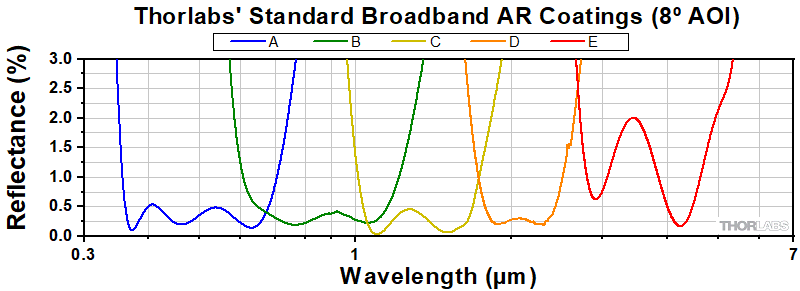
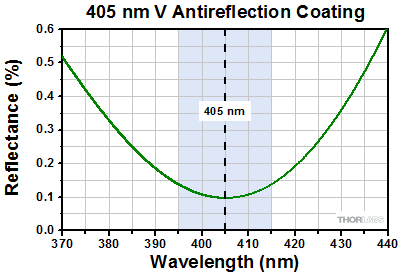
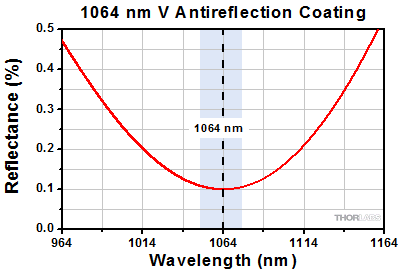
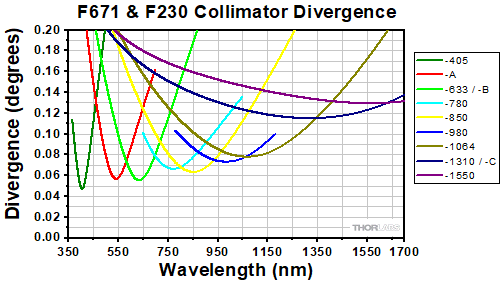
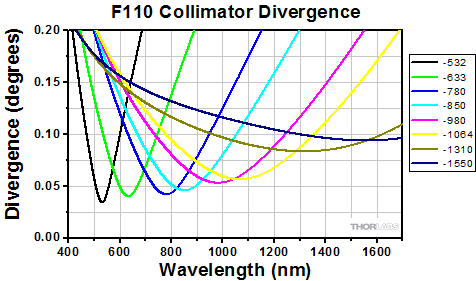



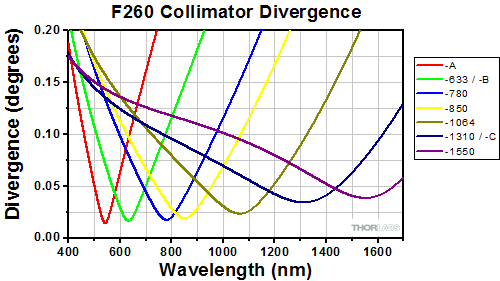
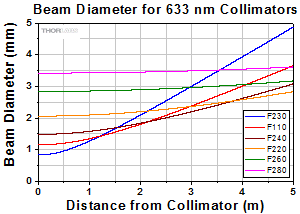

 FC/PC Fixed Focus Collimation Packages
FC/PC Fixed Focus Collimation Packages